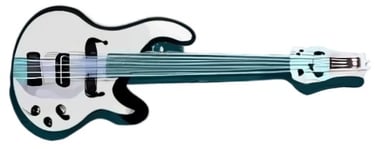
How to Change Guitar Strings Step by Step
Learn how to change guitar strings step by step with this easy guide. Perfect for beginners looking to improve sound and care for their instrument. Let's start!
magicchords.com


Introduction to Guitar String Changing
Changing guitar strings is a fundamental skill that every guitarist should learn, regardless of their experience level. As a guitar owner, understanding the necessity of regularly replacing strings can greatly enhance the instrument's sound quality and playability. Over time, guitar strings wear out due to factors such as humidity, sweat, and general use. As they deteriorate, the tone produced by the guitar can become dull and lifeless, making it crucial for players to become familiar with string maintenance.
For beginners, learning how to change guitar strings is not just a practical necessity but also a valuable lesson in instrument care. Having the ability to replace strings will empower guitarists to optimize their sound and enjoy a more rewarding playing experience. Moreover, this skill fosters a deeper connection with the instrument, as players become more attuned to how their gear works and how it affects their music.
This guide aims to provide a comprehensive, step-by-step tutorial on changing guitar strings, specifically tailored for beginners. Readers can expect to find detailed instructions that cover various types of strings, tools required for the process, and tips to ensure a successful string replacement. By the end of this tutorial, readers will feel confident in their ability to change guitar strings, thus contributing significantly to the overall maintenance and longevity of their beloved instrument. It's time to get started and learn this essential skill, as it will undoubtedly improve the overall guitar-playing experience.
Supplies Needed for Changing Guitar Strings
Changing guitar strings is a fundamental skill that every guitarist should master. To successfully complete this task, certain supplies are necessary. Fortunately, gathering these items is straightforward and will prepare you for a smooth string change process.
The first essential supply is a set of guitar strings. There are various types available, including nylon, steel, and coated strings, each catering to different styles and preferences. When choosing guitar strings, consider the instrument type; for instance, a classical guitar typically uses nylon strings, while electric guitars favor steel strings. Additionally, strings come in various gauges, which refer to their thickness. Lighter gauges are easier to play and bend, making them suitable for beginners, while heavier gauges provide a fuller sound and are often preferred by experienced players. It's advisable for beginners to start with medium gauge strings as they strike a balance between playability and tone.
Another important tool is a string winder, which simplifies the process of tightening and loosening strings. This tool is particularly handy for electric guitar players who need to change strings frequently. Alongside the string winder, you will need wire cutters to remove old strings safely. These cutters should fit comfortably into your toolkit and can also be used for trimming excess lengths after new strings are installed.
A tuner is equally necessary to ensure that your guitar sounds its best after changing strings. Electronic tuners are user-friendly and provide clear visual feedback on string pitch. Alternatively, clip-on tuners can conveniently attach to the guitar headstock, allowing for quick and precise tuning adjustments.
By acquiring these supplies—guitar strings, a string winder, wire cutters, and a tuner—you will be well-equipped to change strings on your guitar efficiently and effectively. Mastering this skill not only enhances your playing experience but also extends the life of your instrument.
Removing Old Strings: Step-by-Step Process
Changing guitar strings is a fundamental skill for any guitarist, and the process begins with the careful removal of old strings. Start by gathering your tools—a string winder can simplify the task, but it is not absolutely necessary. First, make sure you are in a well-lit area and seated comfortably with your guitar.
The first step involves loosening the tension of the strings. This is crucial to avoid any sudden snapping, which can cause injury or damage to the guitar. Gently turn the tuning pegs counterclockwise to reduce tension. If the strings are particularly stubborn, use a string winder to make this process quicker and easier. It is important to loosen each string gradually, ensuring that no one string is reduced in tension more than the others. Once the strings are sufficiently slack, gently push down on each string to check for tension; they should feel loose to the touch.
Next, carefully unwind the strings from the tuning pegs. Starting from the thickest string (the low E string), grip the string near the tuning peg and pull it away. Use your other hand to continue turning the tuning peg until the string is completely unwound. Repeat this process for each string, working your way through to the thinnest (the high E string). As you remove each string, keep an eye out for any frays or kinks that might indicate wear.
Once the strings are free from the tuning pegs, it is time to remove them from the bridge of the guitar. Depending on your guitar type, you may need to push the ball end of the string out through the bridge or simply lift it out. Be cautious during this step to avoid any scratches or damage to the guitar body. If using a guitar with a peg bridge, a little wiggling may help in dislodging the string without any hassle.
Finally, ensure that all the old strings are collected and disposed of properly. This process of removing old strings not only prepares your guitar for new strings but also gives you the opportunity to inspect the guitar for any necessary maintenance. Remember, being methodical and careful during this process can prevent potential harm to your instrument.
Installing New Strings: Step-by-Step Process
Installing new guitar strings can significantly enhance the quality of sound produced by your instrument. Begin by laying the guitar on a stable surface, preferably with a soft cloth underneath to prevent scratches. Select the appropriate gauge of strings suitable for your guitar type, as these contribute to both playability and tone. To start the installation process, remove the old strings by loosening the tension using the tuning pegs. Once the strings are unwound, carefully discard them. Next, clean the fretboard with a soft cloth or specialized guitar cleaner to remove accumulated dirt and grime. This preparation will ensure that the new strings perform optimally.
Once the fretboard is clean, take the first new string and insert one end into the bridge, making sure it passes through the appropriate slot for the correct string gauge. Pull the string through until there is approximately a few inches of slack. This excess slack will help facilitate easier attachment to the tuning peg. For guitars with a tremolo system, ensure the string is seated properly in the saddle to avoid any tuning issues later on.
Next, thread the other end of the string through the corresponding tuning peg. While doing this, it’s essential to maintain traction by holding the string taut. Once threaded, wind the string around the peg in a clockwise direction, ensuring that each coil is neatly stacked beneath the previous one. This technique not only secures the string but also minimizes the chance of slippage during play.
After winding the string, take care to tighten it gradually, ensuring it does not become overly tight or excessively loose. Use a tuner to help you reach the desired pitch. Repeat this procedure for each string, ensuring that they are aligned properly and without excessive slack. Once the strings are all installed, give them a few stretches by pulling gently on each string to help them settle into tuning.
Tuning Your Guitar After Changing Strings
Once you have successfully changed your guitar strings, the next crucial step is to tune your instrument. Proper tuning is essential for achieving the best sound and ensuring that your guitar plays harmoniously. There are various methods available for tuning your guitar, and selecting the right one can depend on your proficiency and comfort level.
One of the most reliable methods is using an electronic tuner. These devices provide a visual representation of the pitch of each string, allowing for precise tuning. To use a tuner, simply pluck a string and observe the tuner display. Adjust the tuning peg accordingly until the tuner indicates that the string is in tune. This method is particularly beneficial for beginners, as it minimizes the potential for error.
Alternatively, tuning by ear is a skill that many guitarists develop over time. To tune by ear, it is helpful to first have one string set to the correct pitch, either through an electronic tuner or by matching it to a reference pitch, such as the fifth fret on the low E string. From there, use relative tuning to adjust the other strings. This involves matching the pitches of strings with one another, which can encourage a more intuitive understanding of sound, although it may take practice to perfect.
New guitar strings often require some stretching to stabilize their tuning. Initially, they may go out of tune quickly as they adjust to tension. Gently pulling on each string, while being careful not to overdo it, can help them stabilize more quickly. Remember to recheck your tuning after this stretching process. Consistent tuning is vital to ensure your guitar sounds its best and is enjoyable to play.
Maintaining Your Strings for Longevity
Proper maintenance of guitar strings is essential for ensuring their longevity and optimizing sound quality. New strings, while offering bright tones and excellent resonance, can quickly lose their appeal without adequate care. One of the primary methods to maintain them is through regular cleaning, which helps to remove oils, dirt, and grime that accumulate from frequent playing. A simple cloth can be used to wipe down the strings after each session, ensuring that any contaminants are removed and potentially extending the life of the strings.
The frequency of string changes is another critical factor in maintaining sound quality. For those who play regularly, it might be necessary to change strings every week or two. Conversely, occasional players may find that changing their guitar strings every month suffices. It is essential to listen to the tone of the strings; if they sound dull or lifeless, it may be time for a replacement. Keeping track of playing habits can also guide how often to change the strings, ensuring the optimal performance of the instrument.
Moreover, protecting guitar strings from dirt and moisture is crucial. When not in use, covering the guitar with a case or a cloth can shield the strings from debris and environmental factors. Additionally, considering the environmental conditions, such as high humidity or extreme dryness, can help in preserving the integrity of the strings. Using a guitar stand or hanger that offers ventilation rather than a closed space can also minimize moisture build-up.
Ultimately, the longevity of guitar strings is a result of regular maintenance, awareness of playing frequency, and proper environmental protection. Investing time in caring for strings will not only enhance their lifespan but also ensure an enriched playing experience.
Common Mistakes and Troubleshooting
Changing guitar strings can be a simple task, but beginners often make common mistakes that can lead to frustration and issues down the line. One prevalent error is failing to release tension properly when removing old strings. Many new players may try to cut the strings while they are still under tension, which can cause damage to the guitar's neck or bridge. It is crucial to loosen the strings completely before removing them to prevent potential damage.
Another frequent oversight is not checking the condition of the guitar's tuning pegs and nut slots before changing strings. Over time, these components can accumulate debris, which may lead to friction and tuning instability. Regular maintenance of these areas can make string changes easier and help with tuning accuracy. Always consider cleaning the nut and tuning pegs with a soft cloth to remove any dust or grime prior to installing new strings.
Beginners may also struggle with incorrect string winding, which can lead to string breakage or poor tuning stability. When winding the strings, ensure they are wrapped neatly around the tuning posts, with each coil sitting closely on top of the previous one. This will provide adequate support and help maintain tuning. A common error is winding the string in the wrong direction, which can cause unnecessary tension and lead to breakage.
If a string breaks during installation or play, it is often due to improper handling or poor-quality strings. Ensure that strings are properly secured at both ends – the bridge and the tuning peg. If a string frequently breaks, consider investigating its gauge and the potential need for replacement parts like a nut or bridge saddle, which may be worn. Maintaining awareness of these common mistakes will empower beginners to troubleshoot confidently and enjoy a smooth string-changing experience.
Changing your guitar strings might seem intimidating at first, especially if you’re new to playing. But with a little guidance and the right steps, it’s a simple and rewarding task that every guitarist should learn. Fresh strings not only improve your sound, but they also make your guitar easier to play and more enjoyable to practice on.
Over time, guitar strings lose their brightness, become harder to tune, and can even break unexpectedly. Regular string changes help maintain consistent tone, reduce finger strain, and protect your instrument from unnecessary wear. Whether you play acoustic or electric guitar, learning to change strings is an essential skill that gives you more control over your instrument’s sound and performance.
In this blog post, we’ll walk you through the entire string-changing process, step by step. You’ll learn what tools you need, how to remove old strings safely, install new ones correctly, and tune your guitar back to perfect pitch. These instructions are beginner-friendly and designed to help you gain confidence with your guitar’s maintenance. By the end of this guide, you’ll be ready to give your guitar a fresh new voice—all by yourself. Let’s get started and bring those strings back to life!


Effective guitar practice routines are key to fast improvement. By following a structured plan with warm-ups, chord changes, and song practice, beginners can build strong foundations and stay motivated throughout their learning journey.
Did you know that with the right tools and guidance, you can learn guitar online and start playing in days. Interactive lessons, video tutorials, and practice tips make it easy for beginners to pick up skills quickly—all from the comfort of home.




